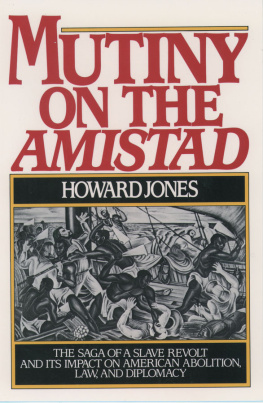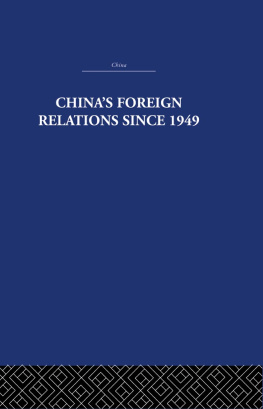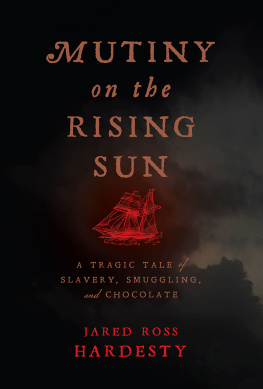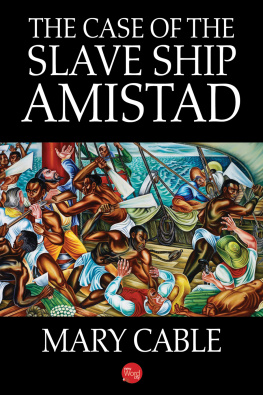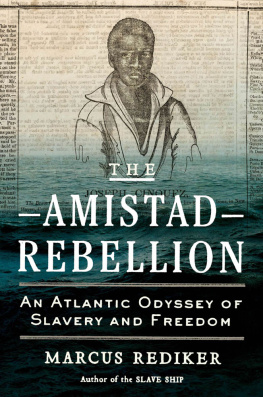
AMISTADS ORPHANS
AMISTADS ORPHANS

An Atlantic Story of Children, Slavery, and Smuggling

Benjamin N. Lawrance

Copyright 2014 by Yale University. All rights reserved. This book may not be
reproduced, in whole or in part, including illustrations, in any form (beyond
that copying permitted by Sections 107 and 108 of the U.S. Copyright Law and
except by reviewers for the public press), without written permission from the publishers.
Yale University Press books may be purchased in quantity for educational,
business, or promotional use. For information, please e-mail
(U.S. office) or sales@yaleup.co.uk (U.K. office).
Set in Electra type by Newgen North America.
Printed in the United States of America.
Library of Congress Cataloging-in-Publication Data
Lawrance, Benjamin Nicholas.
Amistads orphans : an Atlantic story of children, slavery, and smuggling /
Benjamin N. Lawrance
pages cm
ISBN 978-0-300-19845-4 (hardback : alk. paper)
1. Amistad (Schooner) 2. Child slavesHistory19th century.
3. ChildrenAfricaHistory19th century. 4. OrphansAfrica
History19th century. 5. Slave tradeAfricaHistory19th century.
6. Slave tradeAmericaHistory19th century. 7. Human smuggling
AfricaHistory19th century. 8. Human smugglingAmerica
History19th century. I. Title.
E447.L39 2015
326.097309034dc23 2014010385
A catalogue record for this book is available from the British Library.
This paper meets the requirements of ANSI/NISO Z39.481992 (Permanence of Paper).
10 9 8 7 6 5 4 3 2 1
This book is dedicated to Wilson de Lima Silva,
without whose love, support, and encouragement it
would never have been.
The voice of wailing which comes to us from across the Atlantic, from the mourning relations of the deceased companions; or which moans in the night winds and in the surges of the deep that pass over their graves or watery beds, tells us in truer language, than can the survivors of the Amistad, what slavery is in its origin and progress.
Extract of a speech delivered by the Reverend James W. C. Pennington to Mr. Henry and Mrs. Tamar Clark Wilson, Zions Chapel, New York, N.Y., November 19, 1841, on the eve of their departure for Freetown, Sierra Leone, printed in the Union Missionary Herald 1, no. 2 (February 1842): 68

CONTENTS

ACKNOWLEDGMENTS
This book began with a fellowship at the Gilder Lehrman Center for the Study of Slavery, Resistance, and Abolition at Yale University. Although my fellowship was not awarded based on this particular projectbut rather for one about contemporary child trafficking in West Africa (that book is still in development)when I arrived in New Haven, several colleagues, notably Bob Harms, alerted me to the child testimonies from which this book evolved. I would like to express my admiration and appreciation to David Blight, Dana Schaffer, Melissa McGrath, and Tom Thurston, who have worked together to make the GLC a superb research center; to its faculty and staff I owe a tremendous debt of gratitude.
Support for this book came in the form of a faculty fellowship from the National Endowment for the Humanities and the College of Liberal Arts at the Rochester Institute of Technology. I also benefited from the award of a University of California Presidents Faculty Research Fellowship and a residential fellowship at the W. E. B. Du Bois Institute for African and African American Research at Harvard University. The Conable Endowment for International Studies and its donors, especially the Starr Foundation, supported research travel.
A great number of research centers, universities, institutions, archives, and libraries were consulted over the course of several years. I would like to acknowledge the research support of: in the United States, the National Archives and Records Administration, Waltham, Massachusetts; the Amistad Research Center, Tulane University, New Orleans, Louisiana; Special Collections, Feinberg Library, State University of New York at Plattsburgh, New York; Yale University and Library Manuscripts Collection, New Haven, Connecticut; the Beinecke Rare Books Library, Yale University, New Haven, Connecticut; Yale Divinity School Library, Yale University, New Haven, Connecticut; Foreign Missionary Society Collection, in the United Methodist Church Archives, Drew University, Madison, New Jersey; Bethel College Library, Bethel College, Mishawaka, Indiana; the Manuscripts Division, Library of Congress, Washington, D.C.; the History and Genealogy Unit, Connecticut State Library, Hartford, Connecticut; the New York Historical Society, New York, New York; New York Historical Society Library, New York, New York; the Mystic Seaport Museum, Mystic, Connecticut; the Library Manuscript Collection of Duke University, Durham, North Carolina; the Amistad Collection, Connecticut Historical Society, Hartford, Connecticut; the Chicago Historical Society, Chicago, Illinois; in the United Kingdom, the Bodleian Library of Commonwealth and African Studies at Rhodes House, Oxford University, Oxford; the United Kingdom Hydrographic Office, Taunton; the British National Archives, Kew, London; the British Library; the Caird Library, National Maritime Museum, Greenwich; the Cadbury Collection, the University of Birmingham Library, Birmingham; the Archives and Special Collections Library, School of Oriental and African Studies, London; the Brighton History Centre, Brighton Museum and Art Gallery, Brighton; the British and Foreign Bible Society Archives, Cambridge University, Cambridge; the Royal Pavilion and Museums, Brighton and Hove, Brighton; the National Portrait Gallery, London; and additionally, the National Archives of Canada, Ottawa, Canada; the Archivo Nacional de la Repblica de Cuba, Havana, Cuba; Archivo Histrico Provincial de Camagey and the Archivo Histrico Provincial Matanzas in Cuba; and the Sierra Leone National Archives.
An extraordinary community of scholars, students, archivists, cartographers, librarians, photographers, colleagues, and friends made this book possible. I would like to thank the following people who helped in many ways, from the very large to the very small, over the years: Roseanne Adderley, Jean Allman, Richard Anderson, Ruby Andrew, Alexandra Ault, Barbara Austen, Sandra Barnes, Mara del Carmen Barcia Zequeira, Gill Berchowitz, Laird Bergad, Kevin Blowers, Frances Bristol, James Campbell, Mariana Candido, Bidemi Carrol, Bimbola Carrol, Jorge Luis Chinea, Emma Christopher, Lucas Church, Julie Cochrane, Sara Cohen, Kevin Crawford, Carolyn de la Pea, Joan Duffy, Janice Ellen, Omnia El Shakry, David Eltis, Tim Erdel, Jorge Felipe, Mariane Ferme, Silvia Forni, Karen Fung, Orlando Felix Garcia Martnez, Abosede George, Anne George (for photographic assistance), Kurt Graham, Beverley Green, Sandra Greene, Charles Grench, Beverly Grier, Jennifer Hadley, Guy Hannaford, Clare Hasler, Christopher Harter, Ellen Hartigan-OConnor, David Hill, Allen Howard, Mariel Iglesias Utset, Adam Jones, Debra Kimok, Bruce Kirby, Jacqueline Knrr, Jim Lance, Ellen Lawson, Henry Lovejoy, Paul Lovejoy, Katherine Luongo, Melissa Manson, Lucy McCann, Kristen McDonald, Matthew Millard, Joseph Miller, Philip Misevich, Ugo Nwokeji, Jim Oakes, Paul OPecko, Joe Opala, Emily Osborn, Monica Peters, Don Pirius, Susannah Rayner, Marcus Rediker, Richard L. Roberts, Jaime Rodrigues, Rachel Rowe, Padraic Scanlan, Philip Schwartzburg, Suzanne Schwarz, Rebecca Scott, Jeannie Sherman, Brian Shaw, Trudy Southern, Matthew Stackpole, Jim Sweet, Meredith Terretta, Fredrik Thomasson, Ann Totterdell, Konrad Tuchscherer (for bringing the cover photograph to my attention), Alie Mohamed Turay (for super research assistance), Dmitri van den Bersselaar, Jelmer Vos, Jeff Ward, Alison Welsby, Nathaniel Wiltzen, and Lewis Wyman. I cannot thank Marcus Rediker, Joseph Yannielli, and Michael Zeuske enough for everything they shared, consulted on, commented on, and ultimately improved. Walter Hawthorne needs special attention. Walter read everything, and words fail me when I try to describe his generosity of intellect and spirit.
Next page

